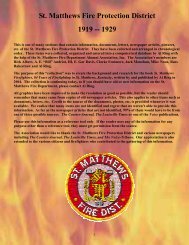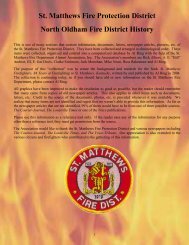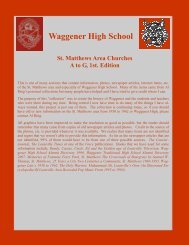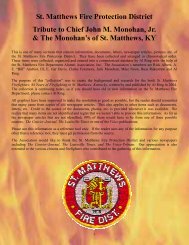Waggener High School Waggener High School History & Photos ...
Waggener High School Waggener High School History & Photos ...
Waggener High School Waggener High School History & Photos ...
Create successful ePaper yourself
Turn your PDF publications into a flip-book with our unique Google optimized e-Paper software.
<strong>Waggener</strong> <strong>High</strong> <strong>School</strong> <strong>History</strong> & <strong>Photos</strong>:Explanation of the following pages, (Please Read)This section is on the history of <strong>Waggener</strong> <strong>High</strong> <strong>School</strong>. Severalalumni have helped by providing information for this section alongwith many articles from The Voice Of St. Matthews. We appreciateeveryone’s contributions. Also, much of the information is fromeditions of the <strong>Waggener</strong> Year books, the Lair.HELP NEEDEDIf you have additional information, photos, etc. please get them toAl Ring so they may be shared with the Alumni of <strong>Waggener</strong> andfriends. Your help is appreciated and needed.You can contact me (Al Ring) at —ringal@comcast.net
<strong>Waggener</strong> <strong>High</strong> <strong>School</strong> <strong>History</strong> & <strong>Photos</strong>: July 27, 1972Courtesy Jefferson Reporter, by Chuck Springer:Educational Television: VanHoose Recalls Birth Of Channel 15, Eyes FutureShortly after Richard VanHoose, superintendent of the county school system, learned that WKPC-TV (Channel 15) hadbeen named recipient of the Corporation of Public Broadcasting’s annual development award, he recalled an encouragingexperience.“I was visiting one of the grade schools in the area,” he said, “And a little boy — he must have been about a third-grader —ran up to me and asked if I wanted to hear him count in Spanish.“I thought he might be able to count up to 10, but I was amazed when he was able to count all the way up to 100.”A Pioneer: The youngster excitedly explained to VanHoose that he had learned to count in Spanish while watching theeducational station. Van Hoose says he has had countless similar experiences since Channel 15 first went on the air in 1958and he “wouldn’t trade them for anything.”VanHoose qualifies as one of the pioneers in educational television.He became interested in the field during the first year of office in 1951 while attending an educational seminar in New York.Television was still in its infancy then, a black and white set cost about $500 and many people had never even seen one.‘That’s Terrific!’: “I looked over the itinerary of the program and saw a subject ‘The future of education in television,’”Van loose recalled, “I thought, ‘Boy! That’s terrific. I believe I’ll check on that.’VanHoose said he returned to Louisville all fired up about the idea and shortly afterward met with Philip Davidson, presidentat the University of Louisville; Skip Graham, library director; and, Omer Carmichael, who was then superintendent ofthe city schools.Everybody agreed that it ~as a good idea and county officials d~w up a proposal asking the ~Fedetal Communications Commissionto include Louisville in its allocation c.~ stations when educational television went into effect.Ford Offers Funds: Luckily for Jefferon County, the Ford Foundation launched an experiment to “teach by television” andput up $25 million to get the project started.“They (the Ford Found ion) were convinced that education could be taught by television,” VanHoose said, “They were verymuch interested in what television could do to re-deploy teachers and cut down on the hum-drum in the classroom and stilldeal with students on a person-to-person basis.”VanHoose didn’t need any further inspiration.“The Jefferson County <strong>School</strong> Board was the only system in a position to take up the challenge,” he said, “so we soon madeapplication for an educational television station.”Following the FCC’s approval of the channel, VanHoose invited all the school districts in the Kentuckiana area to join in acouncil for implementing open broadcast instructional television. The council was formed in January 1958 and open broadcastwent on the air Sept. 8.From an early participation of 6,622 students in the first year, the system now servesall pupils in the city and county systems.Teachers Or Actors? VanHoose recalls that in the beginning the problem was whetherto hire actors and write a good lesson script or to use teachers and - give them someacting lessons.“It’s a rather exacting task to get up there and look that camera in the eye,” ~VanHoosesaid. “We used to bring in students during the early days to give teachers the feelingthat they were actually talking to children.“Today, they’re both actors and professional teachers. There were some actors in theearly days who didn’t know what they were doing; they were only as good as theirscript.”He says educational television has made younger children a lot more intelligent by thetime they reach school age.<strong>School</strong> Anti-Climax: “Children watch television many hours a day, seven days aweek,” he said. “By the time they get to school now, it is kind of an anti-climax.”VanHoose says there is no way to put a price on the value of educational television
<strong>Waggener</strong> <strong>High</strong> <strong>School</strong> <strong>History</strong> & <strong>Photos</strong>: September 29, 1972Courtesy The Courier-Journal, by Jean Nance:<strong>Waggener</strong> PTA leaves state, national organizationsReserves judgment: She later said she was aware that the <strong>Waggener</strong> vote was pending, “but until I get it in writing, I try tomake no judgment whatsoever.“I know large units look at the money they pay in dues (to states and national PTA) and it looks like a lot of money tothem,” she commented.She said that for their money, the units receive from the state “a president’s packet, with two plan’s of work, that is worthwell over $5,” and “field service, publications, mailings pertinent to legislation, and anything that concerns a child thatcomes through from national.”The Kentucky Congress of Parents and Teachers, which has used State Department of Education space in the State OfficeBuilding since its founding in 1918, currently has only two paid staffers, an office director and a clerk-typist, Mrs. Whitesaid.Until late 1966 when the State Department of Education moved into a new section of the State Office Building, the PTAhad rent-free quarters. Asked the amount of rent the organization pays, Mrs. White said that she only gives information inwriting.An official in the education department fiscal management division said that the PTA pays $1,823.52 a year.The headquarters building controversy was fueled when the state PTA board of managers bought a 3/4-acre lot on theThornhill Bypass outside Frankfort in June 1967, at a cost of $10,000.The following year, for the third time the state convention voted down a proposed 10-cent dues increase for a building fund,effectively quashing building plans for the near future.Mrs. White said that donations and memorials have added to the fund, but she did not know the exact amount offhand. Asfor building plans, she said, “It’s just a dream more or less, I’d say. We own a lot and that’s all; we don’t have enoughmoney to make it any more (than that).”It was the land purchase, as well as the dues diversion and “restrictive policies” that prompted the Atherton unit’s pull-out,Atherton spokesmen said at the time.Is trend starting? Whether the <strong>Waggener</strong> departure will start a trend, “it’s a little too early to tell,” Mrs. Clark of the District14 board said. She added that the Atherton move did not have that effect.There is a regularly-scheduled District 14 meeting next Wednesday, for presidents and a trio of delegates from each countyunit, at which the issue is likely to come up. It will be at 10 a.m. in the County Board auditorium on Newburg Road.Talks with present PTA leaders indicated that the newer members are not that familiar with the state headquarters controversy,but are dissatisfied with the way the state arm of the organization is run.“If our money went to other schools that can’t afford some things, we would be glad, but we’ve heard that they (state andnational PTA officers) mostly travel,” said Mrs. Jarett of the Hawthorne PTA.“Also, we had some extremely hard-working women who had gone to quite a few of the state meetings and said they just‘couldn’t get in,’ get to do anything.”The Hawthorne board was also concerned that the national PTA backed busing, something that “Hawthorne fought toothand toenail,” Mrs. Jarett said.Hawthorne is a relatively-small unit, with 168 parents signed up so far this year.Mrs. Jarett pointed out that the Hawthorne board felt no ill will toward the district PTA. “I’ve met some of the district officersand they seem to be really on the bail,” but she said all the unit gets from the national PTA is a magazine.Restraining any urge to cut loose from the parent Parent-Teacher organization is the fear of losing parents “who just like theidea of belonging to the national PTA,” she said. “But if the parents knew our interests were in our children, in spending ourmoney on them, I think they would agree (with the desire to go independent),” Mrs. Jarett added.
<strong>Waggener</strong> <strong>High</strong> <strong>School</strong> <strong>History</strong> & <strong>Photos</strong>: April 12, 1974Courtesy The Courier-Journal:<strong>High</strong>lights from several sections on desegregation (Edited)A chronology of actions taken in school integration caseHere’s a look at how the school-in-tegration case has unfolded:June 21, 1971 — The U.S. Department of Health, Education and Welfare (HEW) ordered the Jefferson County Board ofEducation to remove the “racial identity” of Newburg Elementary <strong>School</strong>.June 28, 1971 — The Jefferson County Board of Education approved seven plans for desegregating Newburg <strong>School</strong> by“pairing” it with other schools.July 13, 1971 — HEW rejected all seven plans.July 27, 1971 — Jefferson Circuit Judge Marvin J. Sternberg ruled that the Louisville school system’s “minority transferplan” for increasing integration was unconstitutional and that the system was integrated.Aug. 7, 1971 — The Jefferson County school board voted to miss the HEW deadline for desegregating Newburg <strong>School</strong>. Italso voted to continue negotiations with federal officials.Aug. 27, 1971 — Kentucky Civil Liberties Union (KCLU) and Legal Aid Society attorneys filed. suit in U.S. District Courtasking for desegregation of the Jefferson County school system.June 22, 1972 — KCLU and National Association for the Advancement of Col-ored People (NAACP) attorneys filed a suitasking for desegregation of the Louisville schools through annexation of all the area inside the city limits but outside thepresent city school bound-aries.Immediately afterward, the Kentucky Commission on Human Rights filed an intervention suit asking that desegregation beachieved through merger of the Louisville, Jefferson County and Anchorage school systems.
<strong>Waggener</strong> <strong>High</strong> <strong>School</strong> <strong>History</strong> & <strong>Photos</strong>: April 12, 1974Courtesy The Courier-Journal:<strong>High</strong>lights from several sections on desegregation (Edited)A chronology of actions taken in school integration caseJuly 10, 1972 — Louisville and Jefferson County Federation of Teachers filed an intervention suit asking that the Louisvilleschools be desegregated by annexing a substantial part of the Jefferson County school district, including the 4th-class citiesof St. Matthews and Shively.Sept. 6, 1972 — U.S. District Judge James F. Gordon ruled that he would not order merger or annexation as a method ofdesegregation. He also dismissed Anchorage from the suit.Dec. 1, 1972 — Trial began before Judge Gordon on the suits filed by KCLU, the Legal Aid Society and the NAACP.March 8, 1973 — Gordon dismissed the suits against the Louisville and Jefferson County school systems, ruling that bothsystems were integrated. An attorney for the civil-rights groups said they would appeal Gordon’s decision.Oct. 3, 1973 — The U.S. 6th Circuit Court of Appeals in Cincinnati heard oral arguments from both sides of the desegregationsuit.Dec. 28, 1973 — The Circuit Court of Appeals ordered a desegregation plan prepared for all three school districts — Louisville,Jefferson County and Anchor-age, reversing Gordon’s decision.March 24.28, 1974 — Louisville, An-chorage and Jefferson County systems ap-peal case to U.S. Supreme Court.April 10.11, 1974 — Anchorage school board files own desegregation plan and Louisville-Jefferson County boards filejoint plan in compliance with U.S. District Court order.
<strong>Waggener</strong> <strong>High</strong> <strong>School</strong> <strong>History</strong> & <strong>Photos</strong>: 1977Courtesy of http://www.skylimit.com/waggenerhigh.nsf, <strong>Waggener</strong> <strong>High</strong>, 1978Scanned this out of the 1977 yearbook...great rendition of <strong>Waggener</strong> at the time.
<strong>Waggener</strong> <strong>High</strong> <strong>School</strong> <strong>History</strong> & <strong>Photos</strong>: January 21, 1981Courtesy of Louisville Times:By Linda Sanders, Staff Writer:“<strong>Waggener</strong> is Needed”Chant kept alive although school not listed for closureOn a blustery Saturday earlier this month, signs began going up all over the St. Matthews area.The marquee in front of a fast-food restaurant read, “<strong>Waggener</strong> is Needed.”The sign for a branch bank said, “<strong>Waggener</strong> is Needed.”In store windows along Shelbyville Road. placards read, ‘<strong>Waggener</strong> Is Needed.”It was all part of a game plan to keep <strong>Waggener</strong> <strong>High</strong> <strong>School</strong> open — a plan devised by parents, teachers and students whohelped defeat the proposed closing of <strong>Waggener</strong> last winter.The parents didn’t slow down when the list of schools recommended for closing this spring came out, even though <strong>Waggener</strong>,at 330 S. Hubbards Lane, was not on the list.They geared up, urging nearby cities to pass resolutions supporting the high school, passing out bumper stickers with the“<strong>Waggener</strong> Is Need-ed” slogan, collecting signatures from business owners who oppose closing the school, speaking beforethe Jefferson County school board.Caries Elliott, father of <strong>Waggener</strong> students Donald, 11, and Dana, 15,. led the campaign.“We made no assumption that the. recommendation would be approved,” he said, Monday, hours before the school boardvoted to close <strong>Waggener</strong>’s middle school but keep the high school open. Westport Road high <strong>School</strong>, at 8100 WestportRoad, will be closed, though, and many of its students will go to Waggoner.Elliott, who works for a bank and lives at 2409 Vinedale Ave. near Browns Lane, said those who formed the <strong>Waggener</strong>support group, known as W.I.N., wanted to keep a positive image up to the moment the school board voted.“We felt like we had to maintain good exposure in very good taste,” Elliott said. “We’ve been very careful not to refer toother schools. We wanted to point out the strong ponts of <strong>Waggener</strong> and then be judged by that.”But even with the school board’s vote behind them, <strong>Waggener</strong> supporters aren’t disbanding.“We’ve got a bigger challenge ahead…,” Elliott said. “We’ve got to prove to them that their decision is right.”Elliott said he thinks <strong>Waggener</strong>’s emphasis on traditional basic education Influenced board members not to close the school.He said parents, teachers and students will have to work together to keep the emphasis on education strong and to integratethe Westport students who will be coming.“We need even more commitment and involvement by parents,” he said.The <strong>Waggener</strong> group, which was formed in late October at the prodding of the school’s advisory committee, conducted astudied, low-key campaign — much as the same people did a year ago when the school board announced. plans to converttheir’ school into a middle school.Last year, parents and students used letters and phone calls to publicize their protest and kept public assem-blies orderly andbusinesslike.This year, Elliott established a structure of supporters, some from last year’s battle and some new ones. They used thebumper stickers, city resolutions and petitions to get their point across.Waggoner Day, the day area busi-nesses displayed “<strong>Waggener</strong> is Needed” signs, came Jan. 10.
<strong>Waggener</strong> <strong>High</strong> <strong>School</strong> <strong>History</strong> & <strong>Photos</strong>: May 18, 1983Courtesy of The Courier-Journal, Neighborhoods East, by Howard Miller, photos Arza Barnett:Arthur Draut closes the book on 29 years at <strong>Waggener</strong>Arthur Draut’s office at <strong>Waggener</strong> <strong>High</strong> <strong>School</strong> has a door to the hallway. He keeps it open.“When I attended high school, my principal was more of an image than a real human being to me,”said Draut, 58, who has been at <strong>Waggener</strong> since the school opened as a junior high in 1954 and hasserved as its principal for 15 years. “I keep the door open so the children can see me.”But the students at the St. Matthews <strong>High</strong> <strong>School</strong> won’t be seeing him much longer.Draut is retiring next month.“It just seemed like a good time to retire,” he said.“My house is paid for and all my children will have graduated from college. I don’t want t be one ofthose guys who hangs on to his job for years and years and then dies 30 days after he retires.”Draut and his wife, Patricia, have been married 33 years and have three sons.Draut began his teaching career at Eastern <strong>High</strong> <strong>School</strong> In 1949. He served on a supply ship duringthe Korean War, then returned to Eastern in 1953. The next year he went to <strong>Waggener</strong> to teach mathand social studies, dispatch buses and work in the storeroom. He later worked as a guidance counselorat the school and served as assistant principal for 10 years.Draut’s activities in St. Matthews aren’t limited to <strong>Waggener</strong>.In 1976 he was appointed to fill the unexpired term of a St. Matthews City Council member who diedin office. He’s been reelected three times, and in the last council election he received more votesthan any other candidate.“He has a feeling for all the community,” said council member Millard French. “He’s been at <strong>Waggener</strong>for so long. He knows all the students who went there and most of their parents.”Draut has seen <strong>Waggener</strong>, which has 1,250 students, with as many as 2,600 in the mid-1960s and asfew as 985 in 1980. He has seen its black enrollment go from zero when it first opened to 20 percentnow.“A lot of things have changed in the years I’ve been here,” he said. He lives at 4306 Churchill Road,only two blocks from the school building, and is used to being called on school business at all hoursof the day and night.“My wife says I’m married to this school,” he said with a laugh. “You can’t plan too far ahead. Youhave to handle problems as they arrive.”Draut’s day is divided among routine office chores such as approving orders for supplies, facultymeetings, observing classroom activities for teacher evaluations and consulting with students.As he walked the hallways recently, he saw a student with his shirt hanging out.“I used to tense up when I saw something like that,” he said. “But I guess you mellow as you getolder.”However, he hasn’t mellowed too much — he doesn’t allow students to wear tank tops or hats inschool. And he would like to see a strict dress code enforced at all county schools, and a requirementthat stu-dents lose credit for unexcused ab-sences as well.“I think you need ground rules,” he said. “Kids are pretty reasonable if they know the ground rules.You need to lay them down and treat everyone fairly.”At lunch time Draut is often in the cafeteria, watching over the school’s a la carte lunch program,one of six in the county system.
<strong>Waggener</strong> <strong>High</strong> <strong>School</strong> <strong>History</strong> & <strong>Photos</strong>: May 18, 1983Courtesy of The Courier-Journal, Neighborhoods East, by Howard Miller, photos Arza Barnett:Arthur Draut closes the book on 29 years at <strong>Waggener</strong>“I was a Supply officer in the Navy,” said Draut, who is a commander in the Navy Reserve. “This isone of my more enjoyable tasks of the day.”Jack Jacobs, a wrestling coach who’s been at <strong>Waggener</strong> for 10 years, said he has appreciated workingwith Draut’s guidance.“He’s one of the finest people I’ve ever been around,” said Jacobs. “He supports us in everything wedo.” The students at <strong>Waggener</strong> have dedicated their 1983 yearbook to Draut, and there will be anopen house at the school in his honor June 5.“I’m sorry to see him go,” said Lee Bissell, 15, a sophomore who lives at 3117W. Muhammad All Blvd. “He’s a good principal who respects his students. It willbe a loss to <strong>Waggener</strong>.”Bob Pilkington, a member of the school advisory committee who has had threechildren attend Waggen-er, is in charge of the open house. “Whoever follows himwill have a lot to live up to,” said Pilkington, of 4307 St. Regis Lane. “He runs atight ship.”Draut said that after his retirement he will devote more time to his duties as a St.Matthews council-man and to his favorite hobbies: swimming and fishing.“I’d like to find some part-time work,” he said, as he continued watching thecafeteria line. “But running a high school doesn’t prepare you for many jobs.”
<strong>Waggener</strong> <strong>High</strong> <strong>School</strong> <strong>History</strong> & <strong>Photos</strong>: May 18, 1983Courtesy of The Courier-Journal, Neighborhoods East, by Howard Miller, photos Arza Barnett:Arthur Draut closes the book on 29 years at <strong>Waggener</strong>
<strong>Waggener</strong> <strong>High</strong> <strong>School</strong> <strong>History</strong> & <strong>Photos</strong>: 1987Courtesy Salley Wood Cox (67):
<strong>Waggener</strong> <strong>High</strong> <strong>School</strong> <strong>History</strong> & <strong>Photos</strong>: January 3, 1990From The Courier-Journal, January 3, 1990, by Joe Koniak. (NOTE: This article did not includeWilliam Gayle Cox or John Harlan Sweet.)Vietnam memorial will bring war home for <strong>Waggener</strong> <strong>High</strong>For now Draut, Fenzel and Clements are sending out more pledge letters and considering whichbooks should stock the shelves.Relatives of the dead soldiers say they’re please with the endeavor.“It’s nice for them to have that in the school for the kids to read and understand a little more aboutwhat went on,” said Edith Hokenson, Wayne Hokenson’s mother. She and her husband, Carl, of HemingwayRoad in Fairmeade, said they will contribute to the biography for the memorial.Librarian Brenda Sheeley expects the section to be frequented by students, many of whom have relativeswho fought in Vietnam.The memorial should prove an educational boon for <strong>Waggener</strong>, Fenzel said.“We hope the students will feel as we do, that his is a very important part of our country’s history,and they will read up about it,” said Fenzel, of Village Drive south of Cherokee Park. “We’re nottrying to press an opinion on them about whether the war was good or bad—we’ll let them draw theirown conclusion. We just want them to learn about it.”From The Courier-Journal, March 6, 1991, by Martha Elson:A page in history<strong>Waggener</strong> accepts book collection as part of its Vietnam memorialVietnam veteran Ron Ray thinks U. S. leaders learned critical lessons from the country’s “long andpainful involvement” in Southeast Asia — lessons that brought about ‘decisive, deliberate, clear objectives”in the Persian Gulf war and widespread national support.Ray and others hope that a new collection of books on the Vietnam War will help <strong>Waggener</strong> <strong>High</strong><strong>School</strong> students learn, too, as they seek to understand Vietnam and make decisions about the future.Three Louisville-area veterans who had attended <strong>Waggener</strong> raised money to buy the books, which arepart of a new <strong>Waggener</strong> <strong>High</strong> <strong>School</strong> Vietnam Memorial. The memorial honors those who served anddied in Vietnam, including six <strong>Waggener</strong> alumni who were killed in the war.The aim, said memorial organizer Ken Draut, is to create a “good educational resource” where studentscan “find out about the good and the bad — read stories of inspiration and stories of despair.”“We wanted to make an effort to bring in all sides,” said librarian Brenda Sheeley.Draut and Ray, a Louisville attorney who was the founder and chief fund-raiser for the Vietnam Warmemorial in Frankfurt, spoke at the dedication of the collection last Wednesday — as news spread ofthe apparent end to the Persian Gulf war.Draut, a 1973 <strong>Waggener</strong> graduate, said the latest war has forced students to talk about patriotism, duty,politics, life and death and that the new collection will enable them to “read about how others facedsimilar issues in the past.”“It’s the least we can do to honor Vietnam veterans,” said Dorothy Bottom, a World War II Armynurse and a member of VFW Post 6376 in St. Matthews, who was in the audience. “They’re deservingof more than we’ve given them.”Draut and the two other <strong>Waggener</strong> alumni — attorney Mark Fenzel and landscape business owner AlClements — raised money for the memorial by soliciting donations from <strong>Waggener</strong> alumni, families ofthe slain soldiers, veterans groups and others. Draut, Fenzel and Clements all served in the military,though not in Vietnam.
<strong>Waggener</strong> <strong>High</strong> <strong>School</strong> <strong>History</strong> & <strong>Photos</strong>: January 3, 1990From The Courier-Journal, January 3, 1990, by Joe Koniak. (NOTE: This article did not includeWilliam Gayle Cox or John Harlan Sweet.)A page in history<strong>Waggener</strong> accepts book collection as part of its Vietnam memorialDraut had the idea for the collection about a year and a half ago, when he discovered he was eligiblefor a $300 Vietnam War era state bonus. Draut had served in the Navy in Guam from 1973 to 1975, butdidn’t think he deserved the money. (Draut, who works for the Kentucky Department of Education inFrankfort, is the son of Art Draut, mayor of St. Matthews and princi-pal at <strong>Waggener</strong> from 1969-83.)Rather than keep the money, Draut decided to use it to create the library memorial. He and the othershave raised $3,384, and have spent about half that amount to buy or order about 150 books.Money left over will be used to buy other books and perhaps to sponsor annual essay contests, Drautsaid.Besides the books, the collection includes a plaque honoring those who served and died in Vietnam,including the six <strong>Waggener</strong> alumni who were killed: William M. Duncan (Class of ‘61), Kirk AllenWoolley (‘61), Thomas Scott Hamilton (‘65), Wayne Allen Hokenson (‘66), Robert Pfeister (66) andWilliam Gayle Cox (67).At last week’s dedication, Draut and Fenzel spoke about the soldiers lives and deaths: how Hamiltondied trying to save several of his fellow soldiers; how Duncan, an only child, was nervous but excitedabout going to Vietnam and how his death was devastating to his parents;” how Woolley was killedwhile being lowered from a helicopter to rescue a U. S. paratrooper trapped in a tree.Yearbook photos of the soldiers are mounted on a plaque in a double bookcase stocked with books andvideos relating to Vietnam. The plaque was donated by Kirk Woolley’s brother, Craig Woolley.Among the titles in the collection are ‘Home Before Morning: The True Story of An Army Nurse inVietnam,” “The Elephant and the Tiger: The Full Story of the Vietnam War,” “A Bright Shining Lie:John Paul Vann & America in Vietnam,” “What Should We Tell Our Children About Vietnam?”Also, “Inside the Green Berets: The Story of the U. .S Army Special Forces” and the fiction work SteelMessage From Nam” by Danielle Steel.Videos include “Vietnam: The Ten Thousand Day War,’ written by Peter Arnett, and “Vietnam: AChronicle of War.” narrated by Walter Cronkite.Also at the ceremony was Vietnam veteran Randy Simms, 42. of St. Matthews, a Trinity <strong>High</strong> <strong>School</strong>graduate. With him was his 11-month-old son, Charles Randall, whose T-shirt read: “My Dad is a Vietnamvet and I’m proud of it.”Simms said he thinks the collection is “fantastic” and that he’s pleased to see “a lot of books on bothsides of the fence.”The Vietnam war, he said, “was the most ridiculous thing. There was no reason to lose 58,000 men.That’s been proved in Desert Storm.”
<strong>Waggener</strong> <strong>High</strong> <strong>School</strong> <strong>History</strong> & <strong>Photos</strong>: 1990Photo courtesy of The Courier-Journal, Neighborhoods, Wednesday March 28, 1990, by GayleCutler Pressman.‘Awesome’ renovation under way at <strong>Waggener</strong><strong>High</strong> school’s 4.6 million project includes air conditioning, new sciences classrooms.By the time <strong>Waggener</strong> <strong>High</strong> <strong>School</strong>’s $4.6 million renovation is finished next year,virtually no part of the three-story, 75-plus classroom building will be the same,aside from its name and 330 S. Hubbards Lane address.The roof won’t leak, and the paint and plaster won’t peel. Electrical wires won’thang exposed, and students won’t bake from summer heat.It will have eight new science classrooms with labs, a new audio-visual room, anda media classroom with a new broadcasting course and teacher to go with it.There’ll be a refurbished gymnasium, cafeteria and library, plus additional spacefor new trophy cases for academics and sports.“We’re taking every system out — electrical, plumbing, mechanical, you name it— and putting new ones in,” said Donna Ludwig. <strong>Waggener</strong>’s principal for sevenyears. “And we’re installing central air conditioning throughout and doing totalcosmetic surgery. “It’s awesome.”The work includes new paint, tile, floor treatments, ceilings, roof, floors and morethan 700 windows. Trenches surround the school for new heating pipes that arebeing installed the length of the building.The project is the first renovation since <strong>Waggener</strong> opened in 1954. Ludwig said itis being paid for with state and local funds to bring the school up to state standards.It has been three years in the planning.“They didn’t just come in here and decide to do this overnight, Ludwig said.“The state and local facilities people walked through the entire building severaltimes. They looked into every closet and examined everything.”
<strong>Waggener</strong> <strong>High</strong> <strong>School</strong> <strong>History</strong> & <strong>Photos</strong>: 1990Photo courtesy of The Courier-Journal, Neighborhoods, Wednesday March 28, 1990, by GayleCutler Pressman.Construction started last August and is scheduled to be finished before the startof the 1991 school year.To meet that timetable, construction crews for C. G. Campbell & Son of GoldsmithLane are working from 7:30 a.m. to 11 p.m. every weekday. And that’smeant extra work for the school’s custodial crew, which has to sweep and mopclassroom and hallway floors more often than usual because of dust generated bythe construction.Just completed is renovation of the smaller of the school’s two gymnasiums. Thatgym, which has a stage, doubles as a theater.New equipment includes electronically controlled bleachers, two lighting systems,a sound system, and acoustical ceiling, paint and stage curtains. The gym lockerroom has new floors, lockers and showers, plus electrical outlets for hair dryers.The gym floor—which was stripped, sanded and restained—remains covered withplastic because the entire contents of the library and science rooms will be storedthere during work in those rooms.To passers-by, the most obvious part of the renovation involves changing theschool’s drab gray concrete exterior to red brick.Freshman Marci Kiefer, 15, agrees. “We had air conditioning at Noe Middle<strong>School</strong>, and I really miss it,” said Marci, who lives on Frankfort Avenue. “It’shot on the second floor, and it makes me so tired I just want to go home and go tosleep.”Ryan Brooks, an 18-year-old junior who lives on Greenmeadow Circle, likes theimprovements so far and wishes the project could be done before he graduatesnext spring.“Besides a little noise, the construction hasn’t been a problem at all,” he said,“and everything’s starting to look better.”“We went into the small gym for passing drills, but we didn’t want to use it, itlooked so nice,” said Brooks, a quarterback for the varsity football team. “I justwish I could be here for the fall of “91.”
<strong>Waggener</strong> <strong>High</strong> <strong>School</strong> <strong>History</strong> & <strong>Photos</strong>: 1991Courtesy Helen C. Cox Nelson:
<strong>Waggener</strong> <strong>High</strong> <strong>School</strong> <strong>History</strong> & <strong>Photos</strong>: 1991Courtesy Helen C. Cox Nelson:
<strong>Waggener</strong> <strong>High</strong> <strong>School</strong> <strong>History</strong> & <strong>Photos</strong>: April 5, 1994From The Courier-Journal, by Holly Holland:<strong>Waggener</strong> seeks to become 3rd traditional high schoolWith a Jefferson County school administration open to expanding the number of magnet schools, <strong>Waggener</strong> <strong>High</strong> <strong>School</strong>has applied to become the latest to offer a traditional program.It’s a move the <strong>Waggener</strong> community seems to support, and it could reduce the waiting list at traditional high schools.“I have a feeling it would cause the school to be improved,” said Ida Bratton, a math teacher who serves as co-chairwomanof <strong>Waggener</strong>’s site-based decision-making council.But some are concerned that the decision was made hastily and with little consultation.“This came out of absolutely no-where as far as I can tell,” said Tony Prince, an English teacher, who said he received amemo about the decision from principal Kathy Hopper last Thursday.The <strong>Waggener</strong> council’s vote to become a traditional school came last Wednesday. Under the plan, the program would beopen to current students beginning next fall and to students from throughout the county in 1995-96.Traditional schools stress a back-to-basics approach, including strict discipline, regular homework and patriotism. They alsohave been able to dismiss students who do not meet behavior or academic standards — a practice resented by non-magnetschools that don’t have the same ability. <strong>School</strong> district officials said the practice is under review.Male and Butler have the only other traditional high school magnet programs. Eastern <strong>High</strong> applied to become the thirdtraditional high school a few years ago but was turned down by the Board of Education.The board also would have to vote on <strong>Waggener</strong> as a district wide magnet. A committee will consider the application laterthis month and make a recommendation to Superintendent Stephen Daeschner, said Jean Green, who supervises optionaland magnet programs.Hopper said <strong>Waggener</strong>’s school council — which includes school staff, parents and students — voted quickly so its applicationcould go before the district committee this month. But efforts to convert <strong>Waggener</strong> to a traditional school have goneon for years, she said, chiefly as a way to boost enrollment. According to school-district statistics, <strong>Waggener</strong> loses morestudents from its attendance district to other public and private schools than any other high school.<strong>School</strong> board member Sam Corbett, whose district includes <strong>Waggener</strong>, said a push has been on for several years to add atraditional high school in eastern Jefferson County because of the huge waiting lists at Male and Butler.“<strong>Waggener</strong> has always been my choice because it’s had such low enrollment,” he said.Walker Cunningham, president of <strong>Waggener</strong>’s Parent-Teacher-Student Association, said he didn’t oppose the school council’svote because he believes a traditional program might boost enrollment. But he doesn’t like traditional schools, and he’snot sure he would continue sending his two sons to <strong>Waggener</strong> under that format.Hopper said she plans to hold several meetings with faculty, students and parents in the next few weeks to discuss the proposal.“I think that you would find that a majority of the faculty as well as a majority of the parents will go along with this move,”she said.But some suggest the discussions should have been held before the council’s vote. Brent McKim, a physics teacher, said heasked a council member before last week’s meeting about the agenda and got no indication a vote on becoming a traditionalschool was planned. The council violated its own bylaws, he said, by voting on a proposal that wasn’t on the agenda.“To make a sweeping change of this magnitude without bringing everyone into the discussion” is wrong, McKim said.Students have mixed reactions. Ebony Woodson, a junior who lives m the Shawnee neighborhood, said he worries that hispierced ear and choice of clothes would not be permitted in a traditional school.“I wouldn’t really want to go back if they changed,” he said.Maria Stiltner, a sophomore from Portland, said teachers would probably have fewer discipline problems in a traditionalschool. But she wonders if the change will mean the school’s Advance Program — an accelerated option for very brightstudents — would have to be dropped.“I can see reasons for it and reasons against it,” she said.Jackie Owens, a sophomore from St. Matthews, just wants more information so she can decide whether to stay at <strong>Waggener</strong>.“I just want to know what’s going on,” she said.
<strong>Waggener</strong> <strong>High</strong> <strong>School</strong> <strong>History</strong> & <strong>Photos</strong>: July 25, 1994From The Courier-Journal, by Beverly Bartlett:Dress blues… <strong>Waggener</strong>’s new clothing rules unpopular with some students, teachersEvery belt loop will have a belt.Every ankle will be covered by a sock or stockings or hose.Every shoelace will be tied. Every sandal will have a back strap.No one will wear shorts—unless the principal so declares.No one will wear a coat in class without the teacher’s permission.Such is the new dress code of <strong>Waggener</strong> <strong>High</strong> <strong>School</strong>. And on the morning of August 29, when <strong>Waggener</strong> students getdressed for the first day of school, the rules that guide their discussions will be the most visible and tangible sign of thechanges that await them.Earlier this year, <strong>Waggener</strong>’s school council decided that the Jefferson county school would adopt a more traditional program,and the dress code is part of that. It is a code that many students and some teachers don’t like. It has prompted twoteachers to try to leave.But Walker Cunningham, a parent member of the school council who was initially skeptical, said he ultimately foundlittle to object to.“We wanted to make it so that we can show the public and the students that were going to attempt a different approach toschool,” he said.He still has qualms, however, about some unpopular parts of the plan — such as requiring that shirts be tucked in.“I know they (students) don’t want it, which concerns me, because I want kids to be able to adjust to this year,” Cunninghamsaid.One married couple who teach at the school have asked to transfer from <strong>Waggener</strong> because they think the code goes too far.“I don’t want to be playing a part in violating a student’s First Amendment rights,’ said Brent McKim, a physics teacherwho has been transferred. Diane McKim. a math teacher, has not yet transferred.Dress codes vary in Jefferson County. Male and Butler high schools, the district’s two official “traditional” schools, haveextensive dress codes that are similar to <strong>Waggener</strong>’s but even stricter.But Male’s and Butler’s students don’t come from designated areas of the county; their students have specifically asked fora “traditional” education, and their parents sign forms indicating they accept the dress code. Students who break the rulescan be sent back to their “home schools.”But <strong>Waggener</strong> is a “home school,” meaning it generally must take all students in its attendance area. The Jefferson CountyBoard of Education hasn’t made it an official “traditional” school that can choose its students.That’s why the <strong>Waggener</strong> school council, consisting of parents, teachers, the principal, staff and students, made its dresscode less strict, said principal Kathy Hopper.But it goes much further than the dress code being worked out at Fern Creek <strong>High</strong> <strong>School</strong>, which also is experimenting witha more tradi-tional program.Starting this year, Fern Creek students can choose a traditional program that includes a dress code similar to <strong>Waggener</strong>’s.But the other students will continue with the same guidelines they’ve always had — general rules that principal JohnSizemore said are like the policies at most Jefferson County schools. Shorts can’t be too short, T-shirts can’t be vulgar, andso on.The district’s general guidance to schools is that rules restricting a student’s right “to choose her or his manner of dress”must have a “specific educational purpose” such as promoting safety or preventing “disruption.”But <strong>Waggener</strong>’s policy “goes way beyond that,” said Brent McKim, “to telling students what kinds of shoes they canwear.”Tony Prince, a <strong>Waggener</strong> English teacher, said he dreads enforcing the rules. “I have a hard time with policies that I can’texplain to kids,” he said.And he doesn’t know how to explain that a girl can wear an un-tucked shirt if it is “designed to wear out,” but a boy can’t.
<strong>Waggener</strong> <strong>High</strong> <strong>School</strong> <strong>History</strong> & <strong>Photos</strong>: July 25, 1994From The Courier-Journal, by Beverly Bartlett:Dress blues… <strong>Waggener</strong>’s new clothing rules unpopular with some students, teachersHe can’t explain why rings can be worn in the ears — as is customary in Euro-pean cultures — but not in the nose or otherparts of the body — a cus-tom in some Asian cultures.Everett Hoffman, executive director of the American Civil Liberties Union of Kentucky, said the U.S. Supreme Court hasnever directly ruled on the constitutionality of dress codes — although it has said that public schools can’t ban political buttonsor political T-shirts.Members of the council who approved the guidelines say they are intended to increase safety or to reduce distractions. Studentscan’t wear coats in class because in some parts of the country students have hidden weapons in their coats, they said.The belt rule is designed to guard against the new style of pants that sag around the hips and occasionally expose underwear— although a separate rule requires pants to be worn at the waist. Very short shorts or short dresses can make it hard forother students to concentrate, some council members said.Repeated violations can bring suspension for up to three days.Bill Treadway, a behavior disorder teacher at <strong>Waggener</strong> and a member of the council, said the rules will teach students howto dress when they leave school. “We thought that the purpose of schools is to prepare students for the busi-ness world,” hesaid.Parent Eva Bulleit also likes the new rules. “My daughter is going to school to get an education,” she said. “If that will helpto prevent distraction .Her daughter Kristie, who will be a junior, agreed that “sometimes, I think it won’t be so bad.” But she doesn’t like the coatban.“Sometimes it’s freezing,” she said. “And you want to wear a coat, but I guess we’re not going to be able to, and we’ll justhave to freeze.”
<strong>Waggener</strong> <strong>High</strong> <strong>School</strong> <strong>History</strong> & <strong>Photos</strong>: July 24, 1996Courtesy of The Courier-Journal, by Martha Elson:<strong>Waggener</strong> alumni get boost from database<strong>Waggener</strong> <strong>High</strong> <strong>School</strong>’s first attempt to form an alumni association four years ago amounted to only a few “Rahs!” at whatwas intended to be a big pep rally for an effort that eventually stalled.But since spring, about 300 people have joined the revived association, thanks to a yearlong search that re-sulted in a databasewith about 10,000 alumni names and publication of an alumni directory.An association organizing committee sent letters to all 10,000, asking them to join the association. Kit Georgehead of Hurstbourne,a 1960 <strong>Waggener</strong> graduate who runs a printing company in the Watterson Park area, handled the mailing and donatedthe stationary, labels and envelopes.All the alumni also are invited to a dinner/dance Oct. 5 at the Seelbach Hotel, where a <strong>Waggener</strong> Hall of Fame also will beinaugurated.“This is part of my vision for <strong>Waggener</strong>,” said Lohelen Hambrick, who became principal last year: “We’re making a realbig deal Out of this. It is extremely important to get the alumni back involved with their alma mater and to let them knowhow much we want them involved.“We’re hoping they are going to be resources for mentoring and consult-ing, as well as being financially sup-portive.”Efforts to find alumni began last summer at <strong>Waggener</strong>, but plans for the association and the October bash got rolling afterHambrick enlisted the help of members of the Class of 1964, who held a party Hambrick attended in January to celebratetheir 50th birthdays.While <strong>Waggener</strong> classes have held a number of successful reunions over the years, “we wanted to expand the efforts of individualclasses ... and tap into that energy,” said association president Larry Ethridge of the Cherokee Triangle, a 1964 graduatewho was at the January party.A reception at a <strong>Waggener</strong>-Male <strong>High</strong> <strong>School</strong> basketball game four years ago to kick off an alumni association drew onlyabout 15 people, and no more events were held.“We never completely stopped thinking about it, but until we had a way to get that database there was no way to reach everyone,”said Marty Coker of Brownsboro Meadows, a 1972 <strong>Waggener</strong> graduate who has been a main association organizerboth times.This time, <strong>Waggener</strong>’s school-based decision-making council decided an alumni association should be a priority for theschool, 330 S. Hub-bards Lane in St. Matthews.And Susan Bauer, <strong>Waggener</strong>’s community liaison, spent almost a year compiling alumni names by researching reunion lists(some of which had been compiled four years ago), annuals and early student address books at <strong>Waggener</strong> and in the schoolsystem’s archives.<strong>Waggener</strong> started as a junior high school in 1954 and was expanded to a high school. Its first high school graduating classwas in 1960.Bauer was able to find names and full or partial addresses and telephone numbers for about 10,000 alumni, which she sentto Bernard Harris Publishing Co., an alumni directory publisher with headquarters in White Plains, N. Y.Harris did more research and found current addresses and phone numbers, plus other information, for about 60 percent ofthose, Bauer said. They are listed in the directory, which was published in April. About 1,500 copies have been ordered orsold for $56.99 or $59.99 each, a Harris spokesman said.Bauer is continuing to update the database on <strong>Waggener</strong> alumni as she receives inquiries about the directory and association,she said.Coker thinks interest in an alumni association would be especially high in the Louisville area.“This is one of the few cities, where, when people ask, ‘Where did you graduate?’ they mean high school rather than college,”Coker said. “People feel strongly about their roots.”Coker’s husband, Lamont, graduated from <strong>Waggener</strong> in 1971, and their son, Jeremy, is a 1995 graduate. Another son, Ryan,will be a sophomore next month.Coker hopes the association will help establish an “identify with the past.” But “it’s more of a pride thing,” she said,“reconnecting with the school ... and regenerating pride for current students.’
<strong>Waggener</strong> <strong>High</strong> <strong>School</strong> <strong>History</strong> & <strong>Photos</strong>: 1996Courtesy of Marie VanHoose Sayre:<strong>Waggener</strong> ‘Hall” will be filled with Cat starsAn impressive list of inductees will be honored by <strong>Waggener</strong> <strong>High</strong> <strong>School</strong>’s first Hall of Fameceremony Saturday, October 5, at the Jefferson Club.Principal Lohelen Hambrick, whose idea it was to start the Hall of Fame, said, “We have somuch tradition and we want to take advantage of it. We want to rekindle that Wildcat spirit!”The inductees are: retired principal Art Draut, St. Matthews mayor; retired teacher KatherineKirwan; Chuck Armstrong, president of the Seattle Mariners; Robert Saxton, a Prichard Committeemember; Rocky Sullivan Thomas, a tennis star; Kit Georgehead, a football standout;Keith Thomas and Paul Long, basketball stars; Chuck Simpson, a federal judge; and RichardGott, a professor at Princeton University.Also included are six graduates who gave their lives in Vietnam:William C. Cox, William M. Duncan, Thomas S. Hamilton, Wayne A. Hokenson, Robert S.Pfeister and Kirk A. Woolley.The dinner is sponsored by the <strong>Waggener</strong> Alumni Association.Tickets are $25 and are available by calling Marty Coker at 561-2302 or the school at 485-8340.The reception starts at 6 p.m. and the dinner at 8 p.m.
<strong>Waggener</strong> <strong>High</strong> <strong>School</strong> <strong>History</strong> & <strong>Photos</strong>: October 5, 1996Courtesy of <strong>Waggener</strong> Library:
<strong>Waggener</strong> <strong>High</strong> <strong>School</strong> <strong>History</strong> & <strong>Photos</strong>: October 5, 1996Courtesy of <strong>Waggener</strong> Library:
<strong>Waggener</strong> <strong>High</strong> <strong>School</strong> <strong>History</strong> & <strong>Photos</strong>: October 5, 1996Courtesy of <strong>Waggener</strong> Library:
<strong>Waggener</strong> <strong>High</strong> <strong>School</strong> <strong>History</strong> & <strong>Photos</strong>: October 5, 1996Courtesy of <strong>Waggener</strong> Library:
<strong>Waggener</strong> <strong>High</strong> <strong>School</strong> <strong>History</strong> & <strong>Photos</strong>: 1997Courtesy of Marie VanHoose Sayre:
<strong>Waggener</strong> <strong>High</strong> <strong>School</strong> <strong>History</strong> & <strong>Photos</strong>: 1997Courtesy of Marie VanHoose Sayre:
<strong>Waggener</strong> <strong>High</strong> <strong>School</strong> <strong>History</strong> & <strong>Photos</strong>: 1997Courtesy of Marie VanHoose Sayre:
<strong>Waggener</strong> <strong>High</strong> <strong>School</strong> <strong>History</strong> & <strong>Photos</strong>: 1997Courtesy of Marie VanHoose Sayre:
<strong>Waggener</strong> <strong>High</strong> <strong>School</strong> <strong>History</strong> & <strong>Photos</strong>: 1997Courtesy of Marie VanHoose Sayre:
<strong>Waggener</strong> <strong>High</strong> <strong>School</strong> <strong>History</strong> & <strong>Photos</strong>: 1997Courtesy of Marie VanHoose Sayre:
<strong>Waggener</strong> <strong>High</strong> <strong>School</strong> <strong>History</strong> & <strong>Photos</strong>: 1997Courtesy of Marie VanHoose Sayre:
<strong>Waggener</strong> <strong>High</strong> <strong>School</strong> <strong>History</strong> & <strong>Photos</strong>: 1999Courtesy of E. Gar Davis (69):
<strong>Waggener</strong> <strong>High</strong> <strong>School</strong> <strong>History</strong> & <strong>Photos</strong>: 2000Courtesy of Marie VanHoose Sayre:
<strong>Waggener</strong> <strong>High</strong> <strong>School</strong> <strong>History</strong> & <strong>Photos</strong>: 2001From the Voice-Tribune, February 14, 2001:Program gives <strong>Waggener</strong> 24-hour access to cop<strong>Waggener</strong> <strong>High</strong> <strong>School</strong> has employed a full-time police officer since 1997, but now students and parents have 24-houraccess to Officer Dennis McDonald, seven days a week.The effort is part of the Phone Call for Safety program, implemented at <strong>Waggener</strong> on Feb. 7.McDonald has built relationships with students while patrolling the halls at <strong>Waggener</strong>, where he is employed full time asa <strong>School</strong> Resource Officer (SRO).The St. Matthews Police Department was the first in the state to initiate the SRO program.It was started as part of a community Policing initiative, McDonald said. We were looking for ways to be proactive in ourschools and community; he said.Now <strong>Waggener</strong> is part of another first--the first Jefferson County school to start Phone Call for Safety. The program ispart of a new initiative bySprint PCS that began in northern Kentucky in July, at high schools in Florence and Erlanger.Sprint gave McDonald a wireless phone and the students have received business cards with his phone number. Studentsand parents can call him with concerns, cilme information, or just for advice. There also are nine phones for teachers.Neither the Phone Call for Safety program nor the daily presence of a police officer at <strong>Waggener</strong> is a result of disciplinaryproblems at the school.It’s intended to be proactive, said <strong>Waggener</strong> principal Jim Jury. It’s not a result of problems or issues in the building.McDonald said, There is a perception that if you place an SRO in a school. That school must have problems when ifsreally the complete opposite. We don’t want any problems, and we’re working proactively to prevent them & quot; (Thisprogram) gives them (officers) quick access to say, ‘I’m following this guy down the hall and I don’t think he should behere,’ " said Ann Welton, public relations and Advertising manager for Sprint PCS of Kentucky. It gives (the officer)the ability to be mobile in a bad situation;<strong>Waggener</strong> is the only Louisville area school that participates in Phone Call for Safety and also the only school partneredwith the St. Matthews police.As a result of its initiative, <strong>Waggener</strong>’s SRO program was recognized by the Center for <strong>School</strong> Safety as a model program.McDonald said the program has been a way to build rapport between the students and police. Over the years, kids havebegun to trust me he said. They know they can bring concerns to me.But there still is concern with being snitch; he said, which is where he thinks the phones will be an effective tool. Sinceworking at <strong>Waggener</strong>, McDonald has received tips on crimes happening in students’ neighborhoods all over town, whichhe has reported to appropriate officers and helped solve.Many students call him for advice -- an integral part of a SRO’s role which involves law enforcement, teaching and advising.For example, McDonald recently taught a class on what to do when stopped by a police officer, a hot topic in thewake of recent police shootings.McDonald said the St. Matthews police department always has emphasized community service, which is why it first implementedthe SRO program. The Phone Call for Safety program should be a positive addition, he said.Young people want to tell you things; McDonald said. They want to tell you if there are problems in life or if they haveconcerns, but many times young people hesitate to tell someone older.Too many times we as adults have failed them. They come to us and we don’t do anything. Fortunately, students here atschool know I’m somebody they can trust to bring their problems and concerns to and I’ll do everything I can to help.
<strong>Waggener</strong> <strong>High</strong> <strong>School</strong> <strong>History</strong> & <strong>Photos</strong>: 2001Courtesy of Marie VanHoose Sayre:
<strong>Waggener</strong> <strong>High</strong> <strong>School</strong> <strong>History</strong> & <strong>Photos</strong>: 2001Courtesy of Marie VanHoose Sayre:
<strong>Waggener</strong> <strong>High</strong> <strong>School</strong> <strong>History</strong> & <strong>Photos</strong>:Courtesy of <strong>Waggener</strong> Traditional <strong>High</strong> <strong>School</strong>:Brochure<strong>Waggener</strong>
<strong>Waggener</strong> <strong>High</strong> <strong>School</strong> <strong>History</strong> & <strong>Photos</strong>:Courtesy of <strong>Waggener</strong> Traditional <strong>High</strong> <strong>School</strong>:Brochure<strong>Waggener</strong>
<strong>Waggener</strong> <strong>High</strong> <strong>School</strong> <strong>History</strong> & <strong>Photos</strong>:Courtesy of <strong>Waggener</strong> Traditional <strong>High</strong> <strong>School</strong>:Brochure<strong>Waggener</strong>See next page for more readable section
<strong>Waggener</strong> <strong>High</strong> <strong>School</strong> <strong>History</strong> & <strong>Photos</strong>:Courtesy of <strong>Waggener</strong> Traditional <strong>High</strong> <strong>School</strong>:Brochure<strong>Waggener</strong>
<strong>Waggener</strong> <strong>High</strong> <strong>School</strong> <strong>History</strong> & <strong>Photos</strong>: Editorial, 2008Courtesy of Al Ring:I’ll start by saying “I was wrong.” By spending the last 5 months collecting (as much information aspossible) and talking to alumni about <strong>Waggener</strong>, I formed some perceptions and thoughts that I nowfind are incorrect.I was under the impression <strong>Waggener</strong> was “not a clean school,” low on the education ladder, aheaven for unruly students, having its own daycare for the children of the students, etc. etc.I recently made a quick trip to Louisville for a family wedding and was fortunate enough to have aguided tour of <strong>Waggener</strong> on Friday morning, May 23, 2008 (last day of school) by faculty memberLynda Draut. She took me where I wanted to go, the library, lunch room, gymnasium, old shopbuildings, TV room and showed me other rooms on the way. She did not “try and sell me on <strong>Waggener</strong>.”She just showed me what I wanted to see and answered my questions.First let’s just say up front, <strong>Waggener</strong> is not perfect. It does have discipline problems, (as do almostevery school in the country, it’s a sign of the times), things are tied down, there is a police officer inthe school while open. It does have locked doors, but I find in asking around this is not unusual. Isit the <strong>Waggener</strong> I remember? NO! In some ways its worse, in some ways its better. It is what it isand I was pleasantly surprised.The school is in very good shape, very clean, painted white walls, and I saw no graffiti. Heck I seegraffiti in the neighborhood I live in today. (On future pages, look at the photos or take a look at the2008 Year Book video to see movies of the school.)Daycare—yes they have one. 20 kids each morning and 20 each afternoon. In 2008, they had childrenwho spoke 8 different languages. This is part of a Early Childhood Jumpstart Program. <strong>Waggener</strong>students can train for entry-level jobs in daycare centers. Very clean and well organized program.Prearchitecture/Construction-The students learn a CAD system and then build models of thehomes they are designing. I met the faculty member in charge of the program. The students arevery lucky to have a man of his stature. By the way, the kids in class were staying late that day andcoming back Tuesday the next week to finish some projects. <strong>School</strong> was over on Friday. When didyou or I come back in the summer? (They already had their grades, this was extra.)I got to see the “News Room” in the Telecommunications department (old TV room.) Theequipment they have is fantastic! Talk about nerd haven. I would go nuts there. The CulinaryArts program (with separate professional kitchen) is magnificent! I just wished they were cookingthat day.What I am trying to say is that <strong>Waggener</strong> has a lot to be proud of and so does its Alumni. It’s a goodschool, problems yes, but what or who doesn’t?I am proud to be from <strong>Waggener</strong> and proud of the school today. I hope you are too.
<strong>Waggener</strong> <strong>High</strong> <strong>School</strong> <strong>History</strong> & <strong>Photos</strong>: 2008Courtesy of <strong>Waggener</strong> Traditional <strong>High</strong> <strong>School</strong>:Agenda
<strong>Waggener</strong> <strong>High</strong> <strong>School</strong> <strong>History</strong> & <strong>Photos</strong>: 2008Courtesy of <strong>Waggener</strong> Traditional <strong>High</strong> <strong>School</strong>:Agenda
<strong>Waggener</strong> <strong>High</strong> <strong>School</strong> <strong>History</strong> & <strong>Photos</strong>: 2008Courtesy of <strong>Waggener</strong> Traditional <strong>High</strong> <strong>School</strong>:Agenda
<strong>Waggener</strong> <strong>High</strong> <strong>School</strong> <strong>History</strong> & <strong>Photos</strong>: 2008Courtesy of <strong>Waggener</strong> Traditional <strong>High</strong> <strong>School</strong>:Agenda
<strong>Waggener</strong> <strong>High</strong> <strong>School</strong> <strong>History</strong> & <strong>Photos</strong>: 2008Courtesy of <strong>Waggener</strong> Traditional <strong>High</strong> <strong>School</strong>:Agenda
<strong>Waggener</strong> <strong>High</strong> <strong>School</strong> <strong>History</strong> & <strong>Photos</strong>: 2008Courtesy of <strong>Waggener</strong> Traditional <strong>High</strong> <strong>School</strong>:Agenda
<strong>Waggener</strong> <strong>High</strong> <strong>School</strong> <strong>History</strong> & <strong>Photos</strong>: 2008Courtesy of <strong>Waggener</strong> Traditional <strong>High</strong> <strong>School</strong>:2008 Introspect
<strong>Waggener</strong> <strong>High</strong> <strong>School</strong> <strong>History</strong> & <strong>Photos</strong>: 2008Courtesy of <strong>Waggener</strong> Traditional <strong>High</strong> <strong>School</strong>:2008 Introspect
<strong>Waggener</strong> <strong>High</strong> <strong>School</strong> <strong>History</strong> & <strong>Photos</strong>: 2008Courtesy of <strong>Waggener</strong> Traditional <strong>High</strong> <strong>School</strong>:2008 Introspect
<strong>Waggener</strong> <strong>High</strong> <strong>School</strong> <strong>History</strong> & <strong>Photos</strong>: 2008Courtesy of <strong>Waggener</strong> Traditional <strong>High</strong> <strong>School</strong>:2008 Introspect
<strong>Waggener</strong> <strong>High</strong> <strong>School</strong> <strong>History</strong> & <strong>Photos</strong>: 2008Courtesy of <strong>Waggener</strong> Traditional <strong>High</strong> <strong>School</strong>:2008 Introspect
<strong>Waggener</strong> <strong>High</strong> <strong>School</strong> <strong>History</strong> & <strong>Photos</strong>: 2008Courtesy of <strong>Waggener</strong> Traditional <strong>High</strong> <strong>School</strong>:2008 Chit-Chat
<strong>Waggener</strong> <strong>High</strong> <strong>School</strong> <strong>History</strong> & <strong>Photos</strong>: 2008Courtesy of <strong>Waggener</strong> Traditional <strong>High</strong> <strong>School</strong>:2008 Chit-Chat
<strong>Waggener</strong> <strong>High</strong> <strong>School</strong> <strong>History</strong> & <strong>Photos</strong>: 2008Courtesy of <strong>Waggener</strong> Traditional <strong>High</strong> <strong>School</strong>:2008 Chit-Chat
<strong>Waggener</strong> <strong>High</strong> <strong>School</strong> <strong>History</strong> & <strong>Photos</strong>: 2008Courtesy of <strong>Waggener</strong> Traditional <strong>High</strong> <strong>School</strong>:2008 Chit-Chat
<strong>Waggener</strong> <strong>High</strong> <strong>School</strong> <strong>History</strong> & <strong>Photos</strong>: 2008Courtesy of <strong>Waggener</strong> Traditional <strong>High</strong> <strong>School</strong>:2008 Chit-Chat
<strong>Waggener</strong> <strong>High</strong> <strong>School</strong> <strong>History</strong> & <strong>Photos</strong>: 2008Courtesy of <strong>Waggener</strong> Traditional <strong>High</strong> <strong>School</strong>:2008 Chit-Chat
<strong>Waggener</strong> <strong>High</strong> <strong>School</strong> <strong>History</strong> & <strong>Photos</strong>: 2008Courtesy of <strong>Waggener</strong> Traditional <strong>High</strong> <strong>School</strong>:2008 Chit-Chat
<strong>Waggener</strong> <strong>High</strong> <strong>School</strong> <strong>History</strong> & <strong>Photos</strong>: 2008Courtesy of <strong>Waggener</strong> Traditional <strong>High</strong> <strong>School</strong>:2008 Chit-Chat
<strong>Waggener</strong> <strong>High</strong> <strong>School</strong> <strong>History</strong> & <strong>Photos</strong>: 2008Courtesy of <strong>Waggener</strong> Traditional <strong>High</strong> <strong>School</strong>:2008 Chit-Chat
<strong>Waggener</strong> <strong>High</strong> <strong>School</strong> <strong>History</strong> & <strong>Photos</strong>: 2008Courtesy of <strong>Waggener</strong> Traditional <strong>High</strong> <strong>School</strong>:2008 Chit-Chat
<strong>Waggener</strong> <strong>High</strong> <strong>School</strong> <strong>History</strong> & <strong>Photos</strong>: 2008Courtesy of <strong>Waggener</strong> Traditional <strong>High</strong> <strong>School</strong>:2008 Chit-Chat
<strong>Waggener</strong> <strong>High</strong> <strong>School</strong> <strong>History</strong> & <strong>Photos</strong>: 2008Courtesy of <strong>Waggener</strong> Traditional <strong>High</strong> <strong>School</strong>:2008 Chit-Chat
<strong>Waggener</strong> <strong>High</strong> <strong>School</strong> <strong>History</strong> & <strong>Photos</strong>: <strong>Waggener</strong> 2008Courtesy of <strong>Waggener</strong> Traditional <strong>High</strong> <strong>School</strong> Web Site.<strong>Waggener</strong>’s Mission and VisionStatements<strong>Waggener</strong> Mission StatementTo provide the essential skills, knowledge, quality, training and self-discipline necessary forthe lifelong needs of our students and to promote their success through a traditionaleducation.<strong>Waggener</strong> Vision StatementTeachers, students, and parents work together, respect each other and communicate witheach other toward achieving a shared vision. Excellence in academics and meeting CATSthresholds is achieved in an encouraging, caring environment. <strong>School</strong> environment is a safelearning zone that promotes student growth and success through zero tolerance policies ondrugs and violence. Students’ pride and school spirit increases as overall student involvementand socialization increases. Administration and teachers are consistent in enforcing policies,reinforcing positive performance and participating in the daily and extra-curricular activitiesof the students. Partnerships are established and promoted with businesses, community organizations,colleges and an active <strong>Waggener</strong> Traditional <strong>High</strong> <strong>School</strong> alumni association.
<strong>Waggener</strong> <strong>High</strong> <strong>School</strong> <strong>History</strong> & <strong>Photos</strong>: <strong>Waggener</strong> 2008Courtesy of <strong>Waggener</strong> Traditional <strong>High</strong> <strong>School</strong> Web Site.
<strong>Waggener</strong> <strong>High</strong> <strong>School</strong> <strong>History</strong> & <strong>Photos</strong>: May, 2008Courtesy of Al Ring:Inside gymnasium, senior breakfast, last dayFront of the old gymnasiumInside gymnasium, senior breakfast, last dayFront entryway, office in backFront entryway
<strong>Waggener</strong> <strong>High</strong> <strong>School</strong> <strong>History</strong> & <strong>Photos</strong>: May 2008Courtesy of Al Ring:Front entryway with office in backLunchroomTelecommunications roomTelecommunications roomTelecommunications room/news roomCulinary Arts, kitchen for students
<strong>Waggener</strong> <strong>High</strong> <strong>School</strong> <strong>History</strong> & <strong>Photos</strong>: May 2008Courtesy of Al Ring:Prearchitecture Construction TechnologyEarly Child Development—daycareComputer LabLibrary, Vietnam MemorialLibrary, much expanded from our time
<strong>Waggener</strong> <strong>High</strong> <strong>School</strong> <strong>History</strong> & <strong>Photos</strong>: May 2008Courtesy of Al Ring:A. K. Draut Gymnasium (New from our time)
<strong>Waggener</strong> <strong>High</strong> <strong>School</strong> <strong>History</strong> & <strong>Photos</strong>: May 2008Courtesy of Al Ring:A. K. Draut Gymnasium (New from our time)
<strong>Waggener</strong> <strong>High</strong> <strong>School</strong> <strong>History</strong> & <strong>Photos</strong>: May 2008Courtesy of Al Ring:
<strong>Waggener</strong> <strong>High</strong> <strong>School</strong> <strong>History</strong> & <strong>Photos</strong>:Courtesy of The Courier Journal, photos by Pam Spaulding:May 23, 2008 GraduationThe 2008 graduation of <strong>Waggener</strong> <strong>High</strong> <strong>School</strong> washeld Friday night May 23 in the East Hall of the KentuckyFair & Expo Center. (By Pam Spaulding, TheCourier-Journal) 5/23/08Fru'Quione Hervey, Mohammad Talib, Nhial Agak andAbdallatif Badwan prior to the ceremony. (By PamSpaulding, The Courier-Journal) 5/23/08Allen Schagene, left, Emily Busch, center, and MeganGittings took their own picture. (By Pam Spaulding, TheCourier-Journal) 5/23/08From left: Vanessa Scotland, Ashley Gaither, MaurisheaGaither and Gerrica Washington all smiled for the camera.(By Pam Spaulding, The Courier-Journal) 5/23/08
<strong>Waggener</strong> <strong>High</strong> <strong>School</strong> <strong>History</strong> & <strong>Photos</strong>:Courtesy of The Courier Journal, photo by FCCLA, October 6, 2008:National good Neighbor DayMay 23, 2008 Graduation<strong>Waggener</strong> <strong>High</strong> <strong>School</strong>'s FCCLA (Family, Career, and Community Leaders of America) wanted todo something extra special for National Good Neighbor Day.National Good Neighbor Day is a day were you do something nice for the school's neighbors.Provide them with a treat of some sort with an accompanying note that expresses thanks for theirpatience with extra traffic, trash, and other inconveniences of having a school in their neighborhood.Our FCCLA Chapter wanted to put together treat bags with a thank you note attached to deliver toall the neighbors that surround <strong>Waggener</strong> <strong>High</strong> <strong>School</strong>.First our FCCLA members got together and stuffed treat bags with candy. Then they signed thankyou notes and attached them to the bags with ribbon.On September 29th, some of the FCCLA members and the advisors marched up and down theneighborhood and delivered the treats to <strong>Waggener</strong>'s neighbors.Some treats they had to leave in mailboxes or on the porch because of the neighbors not at home butallot of them got to personally thank many neighbors and the neighbors seemed very thankful.Before the FCCLA members even returned to <strong>Waggener</strong> a neighbor called and informed the schoolthat this was a very sweet thing to do and they even thanked <strong>Waggener</strong>!!!Celebrating National Good Neighbor Day byFCCLA delivering treats to <strong>Waggener</strong>'sNeighbor's!!(<strong>Waggener</strong> <strong>High</strong> <strong>School</strong>s FCCLA)
<strong>Waggener</strong> <strong>High</strong> <strong>School</strong> <strong>History</strong> & <strong>Photos</strong>:October, 2008, <strong>Waggener</strong> News
<strong>Waggener</strong> <strong>High</strong> <strong>School</strong> <strong>History</strong> & <strong>Photos</strong>:October, 2008, <strong>Waggener</strong> News
<strong>Waggener</strong> <strong>High</strong> <strong>School</strong> <strong>History</strong> & <strong>Photos</strong>:October, 2008, <strong>Waggener</strong> News
<strong>Waggener</strong> <strong>High</strong> <strong>School</strong> <strong>History</strong> & <strong>Photos</strong>:October, 2008, <strong>Waggener</strong> News
<strong>Waggener</strong> <strong>High</strong> <strong>School</strong> <strong>History</strong> & <strong>Photos</strong>: November 26, 2008Courtesy The Voice-Tribune:
















